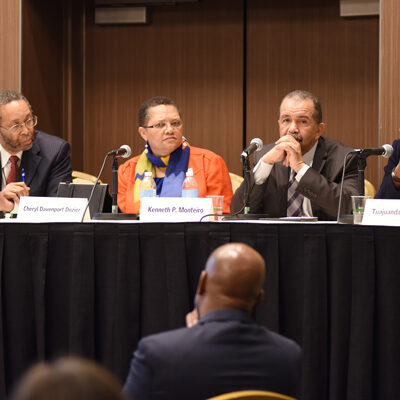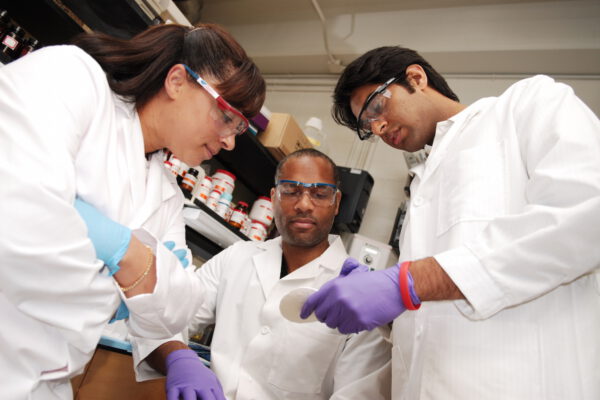By Suzanna Rose
This post is the latest in a series on campus climate and STEM success. ACE is partnering with the National Center for Institutional Diversity at University of Michigan on the series.
Florida International University (FIU) is a Hispanic-serving public university founded in 1965 that serves 56,000 students, 61 percent of whom are Hispanic and 20 percent are from other underrepresented groups. But similar to other universities, that diversity is not always reflected at the faculty level, especially in STEM fields (science, technology, engineering, and math). While in fall 2018, 51 percent of undergraduates in STEM majors were women, less than one-fourth of STEM faculty members were women.
Pushes have been made in recent years to increase representation of underrepresented students such as women, Hispanics, African Americans, and other minorities, in the STEM fields. Just as important as creating interest in STEM among students, however, is achieving and retaining diversity among STEM faculty. Research has shown that having women role models has a powerful positive effect on young women’s performance in math and science classes. And having more role models with whom students can identify can help them imagine a similar career trajectory for themselves.
FIU’s Office to Advance Women, Equity & Diversity (AWED) was established in 2016 to help address this issue. The office’s main program, FIU ADVANCE, is supported by a five-year, $3.2 million grant from the National Science Foundation (NSF) awarded to FIU in 2016. The primary goal of FIU ADVANCE is to develop innovative organizational change strategies to increase the number of women and minority professors in STEM and the social and behavioral sciences.
FIU ADVANCE builds off the success of the university’s 2011 NSF ADVANCE grant for the “Awareness, Commitment and Empowerment (ACE) of Women Scientists at FIU” project, which was designed to facilitate the hiring, retention, and promotion of women in science and mathematics. At the time, Yesim Darici, STEM assistant provost and physics professor, and I saw a need for programs that fostered a sense of community among women faculty members and addressed implicit bias when dealing with diversity and inclusion.
We began a five-year intervention project to increase the number of tenure-line women faculty in STEM, resulting in an increase from 12 percent in 2011 to 17 percent by 2016. FIU ADVANCE has continued to both build upon programs that came out of the 2011 grant and create new ones, with the aim to advance diversity and inclusion at FIU at several steps along the faculty timeline.
Below are four such programs other colleges and universities could use as models as they pursue equity and representation.
Teach search committee members best practices
The Strategies and Tactics for Recruiting to Increase Diversity and Excellence (STRIDE) Committee provides workshops each semester for faculty members who are serving on search committees. Originally developed by the ADVANCE program at the University of Michigan, these workshops are designed to provide background information and concrete advice about practices that make searches more successful, both in producing a more diverse candidate pool and in hiring diverse faculty.
To date, more than 350 faculty have participated in STRIDE workshops, and as of fall 2017, the workshops were institutionalized (with a three-year phase-in) to be required of faculty search committee members in all colleges and departments at FIU.
Learn how to recognize implicit bias
The Bystander Leadership Program aims to educate faculty on implicit bias by raising awareness about the interplay between power, privilege, and bias often experienced by women and minorities. It also provides a range of responses and actions that can be used to address instances of bias. AWED uses research-based interactive theater to present skits tailored to the academic setting, which allow attendees to interact with each other and the curriculum.
Subsequently, attendees take an active role in intervention scenarios, practicing the skills they learned during the workshop and developing the experience necessary to engage in real-world situations. The overwhelming majority of participants who completed surveys reported that the workshop increased their confidence about using prosocial intervention skills and strategies, and said they were more likely to intervene in similar situations after the workshop.
Connect women across universities
Because networking and mentorship are valuable to building relationships, the ADVANCE Florida Network (AFN) provides professional opportunities to women in STEM at the three urban public research universities that comprise the Florida Consortium of Metropolitan Research Universities: FIU, University of Central Florida, and University of South Florida. Under the program, women who are tenure-line STEM faculty and postdoctoral associates can receive funding to offer research seminars at departments from any of the other metropolitan universities as a way to develop research collaborations and networks while increasing their professional visibility.
The AFN has already yielded positive results. For example, during an AFN visit in spring 2018, one faculty member told a participant about the McKnight Junior Faculty Fellowship, which she eventually received. Another faculty member agreed to be the participant’s mentor for the William T. Grant Scholars Program—and she was chosen as one of the six scholars that year. Another participant was encouraged during her visit to apply for an NSF CAREER award, which she was recently awarded.
Individualize diversity and inclusion plans
AWED has also led the charge in helping the FIU colleges and departments to develop diversity and inclusion action plans. These plans are crucial to fostering institutional change, as it is not enough to have “one office” to tend to diversity and equity within a university.
The units were asked to select priority areas, responsible parties, and metrics for their plan to ensure that the plans were specific, measurable, and results-focused. Departmental diversity and inclusion plans that include specific actions, the faculty member responsible for the action, and a metric to assess performance on that action annually by the department and the dean are a way to expand the number of stakeholders working to achieve a better environment for all.
One of the most important lessons learned thus far through the program’s development is that awareness about diversity and equity, while an important first step in improving climate, does not necessarily lead to change. Faculty members need to feel engaged and empowered to take action in response to unfair or biased workplace situations. Interactive engagement with the issues at hand via role-playing, theater skits, and active practice of strategies can result in deeper learning and more positive and effective interventions from faculty. Similarly, structured networks—such as those described here—that offer visibility and opportunities to collaborate can play a crucial role in helping the academic careers of members from underrepresented groups to flourish.
If you have any questions or comments about this blog post, please contact us.


